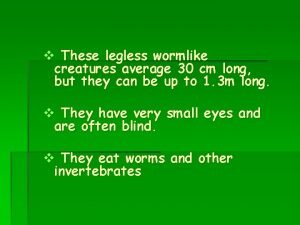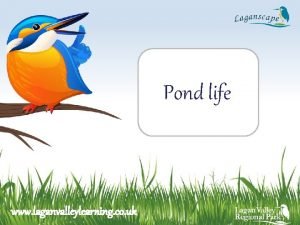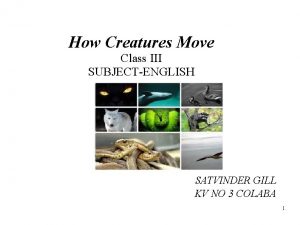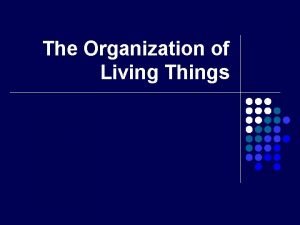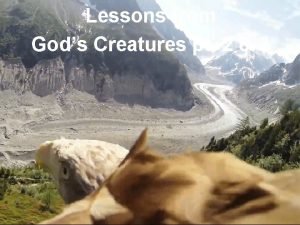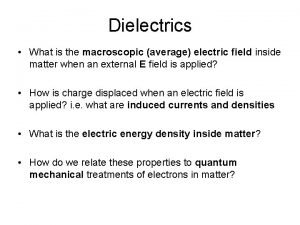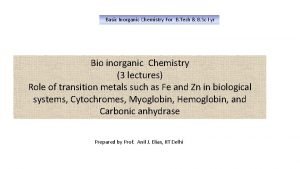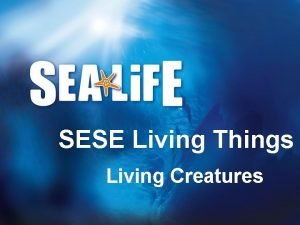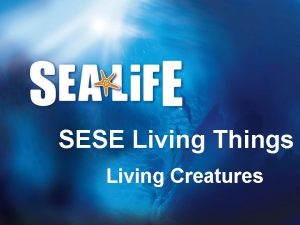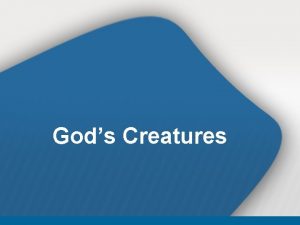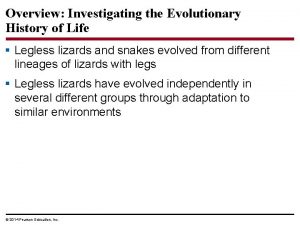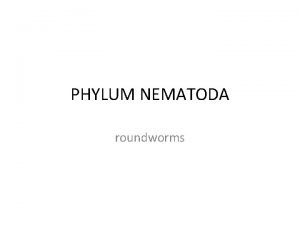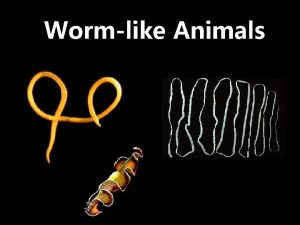v These legless wormlike creatures average 30 cm





































- Slides: 37

v These legless wormlike creatures average 30 cm long, but they can be up to 1. 3 m long. v They have very small eyes and are often blind. v They eat worms and other invertebrates

The caecilian male deposits sperm directly into the female, and the female bears live young

Trachystoma Characteristics

v. The Order Trachystoma contains three living species of mud eels, or sirens. v. Sirens live in the eastern United States and north eastern Mexico.

Frog External Anatomy

q. The frog's powerful hind legs are equally effective in jumping or swimming. On land frogs sit with their hind legs folded against the body, poised to jump at the first sign of danger. q. Most frogs can make leaps many times their body length

Frog's eyes also work equally well in or out of water. Because the eyes bulge out from the head, the frog can stay submerged while literally "keeping an eye out" for predators

q. Eyelids that can blink protect the frog's eyes from dust and dehydration q. In addition to upper and lower eyelids, a third, transparent eyelid called a nictitating membrane covers each eyeball and joins the lower eyelid q. This membrane keeps the eyelid moist and protects it when it is under water

Frogs have eardrums, or tympanic membranes, which are circular structures located behind each eye Tympanic membrane

q. The frog's thick, moist skin serves two important functions— respiration and protection q. Glands secrete mucus to keep it from drying up

Some glands secrete foul-tasting or poisonous substances that protect the frog from enemies

Some frogs, such as Hyla versicolor, can change color in order to blend with the environment. Count the number of frogs in the picture?

Frog Internal Anatomy

Skeletal System q. The frog's spine has nine vertebrae q. The cervical vertebra at the anterior end of the spine allows neck movement that helps frogs catch prey

Skeletal System q Posterior to this are seven trunk vertebrae, and then a single sacral vertebra that supports the hind legs q A long, slim bone called the urostyle extends from the sacral vertebra

Skeletal System q Bones of the pectoral girdle, which form the shoulders, connect to the front legs q They also provide the primary protection to the internal organs, since the frog has no ribs q The pelvic girdle connects to the hind legs

Digestive System

Digestive System q Most frogs feed on insects, and their digestive system is adapted to their diet q A frog's tongue is an excellent insect catcher. The frog simply flicks out its long sticky tongue, curls it around its prey, and pulls the insect back into its mouth. Then the frog snaps its mouth shut and swallows.

Digestive System Frogs have two types of teeth that hold on to prey. A row of maxillary teeth line the perimeter of the upper jaw. Two patches of vomerine teeth project from bones in the roof of the mouth.

Digestive System q Sometimes the frog blinks, pulls its eyes inward, and presses them against the roof of its mouth. This action helps push the food down its throat q Digestion in frogs takes place in the alimentary canal, which includes the esophagus, stomach, small intestine, large intestine, and cloaca

Circulatory System q An adaptation to the greater oxygen needs of land animals is a more efficient circulatory system than the fish's two-chambered heart. q The amphibian's threechambered heart partially mixes oxygenated with deoxygenated blood and pumps the blood throughout the body at higher pressure than does the fish's heart

q The left atrium receives oxygenated blood from the lungs, and the right atrium receives deoxygenated blood from the body. q Both the atria empty into the ventricle, the main pumping chamber of the heart. q In the ventricle oxygenated and deoxygenated blood mix partially and are pumped to the lungs and the rest of the body. Blood to body Deoxygenated blood from body R Oxygenated blood from lungs

q From the right atrium the blood enters the single ventricle. The ventricle then contracts, pumping some blood to the lungs to receive oxygen and some to the rest of the body. q The blood going to the body leaves the ventricle through the conus arteriosus, a large vessel that lies against the front side of the heart

q. This vessel divides into a right and a left truncus arteriosus, which immediately branch again into three arches that carry blood to various parts of the body. q. Deoxygenated blood travels in veins back to the right atrium from the various regions of the body. q. Oxygenated blood returns from the lungs to the left atrium via the pulmonary veins


Respiratory System q. Tadpoles respire, or exchange carbon dioxide and oxygen, through gills

Respiratory System q. Adult frogs lose the gills but can respire in three ways: through the lungs, through the skin, and through the mouth. q. Respiration through the lungs is called pulmonary respiration. q. A frog breathes by changing the volume and pressure of air in its mouth while either opening or closing its nostrils

Respiratory System q Air moves from the throat to the lungs through a slit-like passage called the glottis. q Because the frog's lungs are small, cutaneous respiration, or respiration through the skin in both air and water, is very important, especially during estivation or hibernation. q Oxygen can diffuse across the lining of the mouth and into the blood. q Frogs use mouth breathing for only a relatively small amount of their respiration.

Excretory System q. Urine and wastes from the digestive system are eliminated through the anus. q. When a frog is in water, its permeable skin allows the water to enter its body. q. Frogs that live primarily in water rid themselves of excess water by excreting a large volume of very dilute urine. q Frogs that live mainly on land conserve water by producing a small volume of more concentrated urine.

Excretory System q Amphibians eliminate two primary types of metabolic waste products—carbon dioxide from respiration and waste com pounds from the breakdown of foods. q Are the primary excretory organs and lie on either side of the spine against the dorsal body wall. The kidneys filter nitrogenous wastes from the blood

The Nervous System q The frog brain is more complex than the fish brain, enabling the frog to contend with a more varied environment. q The optic lobes, which control vision, lie behind the cerebrum. q The cerebellum, a small band of tissue lying at right angles to the long axis of the brain, is the center of balance and coordination.

Nervous System q The medulla oblongata lies at the back of the brain and joins the spinal cord. It controls organ functions. q Ten pairs of cranial nerves extend out directly from the brain. q The spinal cord transmits signals from all parts of the body to the brain and from the brain back to the body. q The spinal nerves branch from the spinal cord to various parts of the body.

Reproductive System q Both male and female frogs have internal sex organs q The male frog's fore leg muscles and first fingers swell q These swellings help the male maintain his grasp on the female q The reproductive system of the male frog includes two beanshaped creamy white or yellowish testes located near the kidneys q Sperm cells develop in the testes and pass through tubes to the kidneys and urinary ducts Male System

Reproductive System q Female frogs a pair of large, lobed ovaries containing thou sands of tiny immature eggs lie near the kidneys q During the breeding season eggs enlarge, mature, and burst through the thin ovarian walls into the body cavity. q They remain in structures called ovisacs until ovulation is complete and then leave the body through the cloacae opening. Female System

Reproductive System § The vast majority of eggs and tadpoles are eaten by predators such as fish, birds, snakes, and turtles. Some species of frogs have § The vast majority of eggs and tadpoles are eaten by predators such as fish, birds, snakes, and turtles. Amplexus

Metamorphosis q. Newly hatched tadpoles live off yolk stored in their bodies. They gradually grow larger and develop three pairs of gills. q. Tadpoles have a two-chambered heart. Tadpoles can also regenerate injured or lost body parts such as a leg or tail. q. Legs grow from the body, and the tail disappears.

Metamorphosis § The mouth broadens, developing teeth and jaws. A saclike bladder in the throat divides into two sacs that become lungs. The heart develops a third chamber. § A hormone called thyroxin circulates throughout the bloodstream and stimulates metamorphosis. § The cells of the tad pole are genetically programmed to respond to thyroxin at the appropriate stage of development.
 Legless creatures
Legless creatures Differentiate between average speed and average velocity
Differentiate between average speed and average velocity Remember
Remember Rock pool creatures
Rock pool creatures Comparison context clues examples
Comparison context clues examples Vampire werewolf slavic
Vampire werewolf slavic Cute pigs
Cute pigs Small living creature tom
Small living creature tom Proverbs 25 gnt
Proverbs 25 gnt Pond water identification chart
Pond water identification chart Four living creatures covered with eyes
Four living creatures covered with eyes Restatement/synonym clues examples
Restatement/synonym clues examples Unbelievable sentence
Unbelievable sentence How to use a dichotomous key
How to use a dichotomous key Puksa meaning
Puksa meaning Etymology examples sentences
Etymology examples sentences How creatures move poem
How creatures move poem Limited liability companies are creatures of
Limited liability companies are creatures of Mythological creature half man half horse
Mythological creature half man half horse Underworld rulers
Underworld rulers Organization of living things
Organization of living things Animal myth from bulgaria
Animal myth from bulgaria Small living organisms
Small living organisms Piscatorial creatures
Piscatorial creatures Gods creatures download
Gods creatures download What two creatures does edward compare sinners to
What two creatures does edward compare sinners to Diana vesta
Diana vesta What soft cherubic creatures analysis
What soft cherubic creatures analysis Carl schissler
Carl schissler Average rate of change with integrals
Average rate of change with integrals Interpreting velocity time graphs
Interpreting velocity time graphs Average electric field
Average electric field Exponentially weighted average
Exponentially weighted average Minimum point of average cost curve
Minimum point of average cost curve An average
An average Txdot construction production rates
Txdot construction production rates What is a firm
What is a firm Dr dalia kamel oncologist
Dr dalia kamel oncologist
